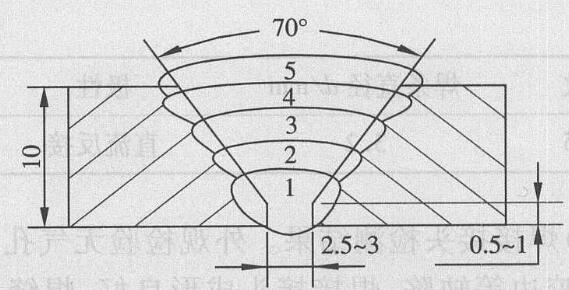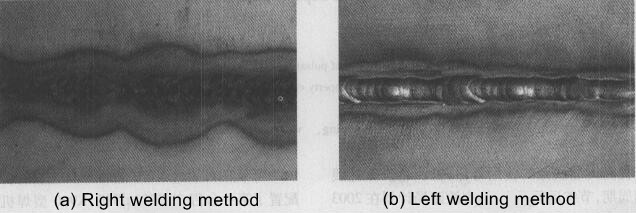Introduction of welding process for corrosion-resistant nickel-based materials Alloy C-276 according to the weldability of C-276 and the development of practical welding process parameters. The test shows that certain process measures must be taken during GTAW welding to prevent oxidation on the back of nickel alloys and reduce the generation of weld defects.
0. Preface
Alloy C-276 is a corrosion-resistant wrought nickel-chromium-molybdenum alloy. It can prevent the formation of grain boundary precipitates in the heat-affected welding zone, has excellent resistance to pitting corrosion and stress corrosion cracking, has good resistance to sulfides and chloride ions, and cannot be heat treated as a solid solution after welding. Therefore, the as-welded condition can be used for most chemical processing techniques. It is one of the few materials that can withstand the corrosive effects of chemical media such as wet chlorine vapor and hypochlorite, and is widely used in areas of severe corrosion in flue gas desulfurization systems.
1. Properties of C-276 alloy
Alloy C-276 can be forged, hot forged and stamped. Although the alloy tends to harden quickly, it resists deep drawing, drawing, press forming, and stamping very well.
Alloy C-276 has low fluidity and can be welded using the chromium-nickel-austenitic stainless steel welding process such as SMAW, GTAW, GMAW or SAW. For parts used in corrosive environments, welding using oxyfuel and submerged arc processes is not recommended. Particular attention must be paid to certain measures to prevent excessive heat entry into the weld.
C-276 has a high coefficient of linear expansion and is susceptible to thermal cracking. Thermal cracks are divided into crystalline, liquid and plastic loss cracks at high temperatures.
Crystallization cracks are most likely to occur in the arc of the weld channel, forming a fire opening crack that runs most often along the weld centerline longitudinally, but also perpendicular to the weld axis. Liquefaction cracks occur in the heat-affected zone immediately adjacent to the fusion line, and some also occur in the front layer of multilayer welds. Loss of plastic cracks at high temperatures can occur in the heat-affected zone and in the weld seam. Various thermal cracks are sometimes macroscopic, but sometimes there are only microscopic cracks. Thermal cracks occur at high temperatures and do not expand at room temperature.
The fluidity of liquid weld metal is poor; the connection chamfer angle must be larger to use the turning method; In addition, the melting depth of the weld metal is small, and the thickness of the blunt edge of the joint should be thinner than other steels. Process characteristics cannot be improved by increasing the welding current; a welding current above the recommended range not only causes the weld pool to overheat and increase susceptibility to thermal cracking, but also causes the deoxidizer in the weld metal to evaporate and create porosity.
(1) Test plate with dimensions 400mm × 125mm × 10mm (2 pieces), base material is C-276 from Thyssen Krupp VDM. Its chemical composition is shown in Table 1. The density of the base material is 8,921 kg/m 3 .
(2) Ws-400 inverter welding machine with dual-use power source for manual tungsten arc welding and electrode arc welding from Era was selected.
(3) Welding wire for the production of ERNiCrMo-4 by the company SPECIAL METALS, manual tubular wire, its chemical composition is shown in Table 2, welding rod for the production of ENiCrMo-4 by the company SPECIAL METALS, its chemical composition is shown in Table 3 listed.
Table 1 Chemical composition and mechanical properties of C-276
| Chemical composition (%) | Mechanically | ||||||||||||
| W | Cr | No | Mo | Faith | v | co | B | Mn | Yes | P | s | Tensile strength σ b /MPa |
H stretch limit σ 0.2 /MPa |
| 0.005 | 16.2 | grant | 16.2 | 5.3 | 0.17 | 0.4 | 3.4 | 0.5 | 0.092 | 0.01 | 0.003 | 746 | 347 |
Table 2: Chemical composition of the welding material
ERNiCrMo-4 wire (%)
| W | Cr | No | Mo | Faith | v | co | B | Mn | YOUR | P | s | AI | Ass | No. | Other |
| 0.003 | 15.91 | 59.24 | 15.23 | 5.77 | <0.01 | 0.01 | 3.23 | 0.39 | 0.01 | 0.004 | 0.001 | 0.2 | <0.01 | <0.01 | <0.5 |
Table 3 Chemical composition of ENiCrMo-4 welding electrode (%)
| W | Cr | No | Mo | Faith | v | co | B | Mn | Yes | P | s | Ass | Other |
| 0.013 | 4:32 p.m. | 59 | 3:29 p.m. | 5.4 | 0.028 | 0.047 | 3.35 | 0.24 | 0.09 | 0.01 | 0.001 | 0.08 | <0.5 |
The electrode diameter is 3.2 mm; the electrode must be dried at 150 °C. ℃ and isolated for 2 hours before welding; When using, place them in the electrode insulation cylinder and carry them while walking; the electrode should not be left out of the oven for more than 4 hours.
(4) Auxiliary tools of angle grinder, welding rod insulating cylinder, concave groove copper pad, stainless steel brush, welding measuring tape, etc.
(5) Before welding each test plate, the chamfered surface and chamfered edge in the range of 20mm are polished cleanly with an angle grinder to expose the metal luster. The blunt edge is ground to a size of 0.5-1 mm and then chamfered with acetone, removing about 20 mm on both sides. If the surface oxide is not clean, fine, discontinuous slag or oxide may form. S, P, etc. can form a low melting point eutectic with Ni, which increases the tendency to thermal cracking.
(6) Preheating is generally not required before welding. However, if the temperature of the base material is less than 15°C, ℃ the compound should be heated to 15-20 ℃ in an area of 250-300 mm wide on both sides to avoid moisture
Condensation. Generally, heat treatment after welding is not recommended, but sometimes heat treatment is necessary for intergranular corrosion or stress corrosion cracking.
(7) Chamfer shape and position welding are problematic due to the large coefficient of linear expansion of C-276. The weld seam shrinks significantly after welding. If the chamfer angle and gap are too small, the last part of the welded bottom channel will appear without gap, resulting in the inability to fully weld the weld. Choose a bevel angle of 60°-70° and a group distance of 2.5-3mm. See Figure 1. After mounting the test plate on the chamfer on both sides of the position weld end, the thickness of the position weld is 1 to 2 mm. The test plate is reserved for 5°-6° deformation resistance.
(8) The welding process for nickel-based corrosion-resistant alloys is similar to the welding process for obtaining high-quality stainless steel welds.
Manual tungsten arc welding was selected for basic welding, one electrode is cerium tungsten electrode, model WC-20, specifications ϕ2.5mm, taper angle 30°-60°, flat tip, diameter of about 0 .4mm. Protection against argon gas, purity 99.99%, nozzle diameter ϕ12 mm.
When soldering, the back is provided with a concave groove copper pad, and the shielding gas protects the back of the solder to prevent oxidation. To ensure good fusion with the root, the weld seam should not be too thick during bottom welding. Close the bow with a slow tilt, release the bow when the bow well is filled, e.g. B. If the arc shrinks or the arc well cracks, and when welding again, use an angle grinder that allows grinding. Specific welding parameters are listed in Table 4.

Figure 1 Bezel shape and size
Table 4: Welding Parameters Table
| level | Welding wire diameter d/mm | polarity | I/A welding current | U/V arc voltage | Welding speed v/(cm.min -1 ) | Front argon flow rate Q/(L.min -1 ) | Argon return flow rate Q 1 /(L.min -1 ) |
| 1 | 2.4 | DC direct connection | 95-110 | 10-12 | 10-15 | 12-14 | 8-10 |
The main problem of manual tungsten arc welding is back protection. When this is present, it leads to better shaping of the back. After testing, with the correct welding method, the back of the molten metal along both sides of the base material is separated from the trend and cannot be detected. This phenomenon can be avoided by using the left welding method. The back is very well formed, see Figure 2.
In addition, you can also use a “Solar Flux” supporting agent, which forms a solder protective coating on the back of the solder to effectively prevent oxidation. At the same time, its wetting behavior can ensure that the molten weld metal completely penetrates through the weld root. Its surface adhesion to the molten metal after heat melting has a supporting function and performs a back-coating function. When using the back shield, the current needs to be slightly increased to about 110A using the internal wire filling technique. The back of the weld cannot be closed when stick arc welding is used for priming.
The other layers are selected for electrode arc welding. The process of welding nickel alloys is similar to the welding process to obtain high-quality stainless steel welds. The interlayer temperature is controlled at 150°C or less. Since the melting depth of liquid nickel alloys is smaller and the mobility of liquid weld metal is low, welding parameters must be strictly controlled during welding changes. The general requirement is to swing the welding rod correctly. The oscillation must not exceed three times the diameter of the welding rod. Try to use a flat welding position. It is necessary to use short arc welding with arc interruption to slightly reduce the height of the arc and increase the welding speed to reduce the size of the weld pool, which can reduce fire cracking. The welding process parameters are listed in Table 5.

Figure 2 Comparison of Molten Metal Molding Using Argon Gas Shielding
Table 5: Welding process parameters
| level | Welding wire diameter d/mm | polarity | I/A welding current | U/V arc voltage | Welding speed v/(cm.min -1 ) |
| 2-5 | 3.2 | DCRP | 80-1 10 | 22-24 | 15-20 |
(9) Weld seam test results. When examining the appearance, no porosity, sweat tumors, depressions, edge lesions and other defects are found; the welds are well formed; the welding surface is smooth. Using the above process measurements and welding parameters, welding through radiation flaw detection meets the requirements of JB4730-1994 for Class I film, without fusions, cracks and other defects. Tensile tests on the specimen σ b are above 800 MPa; End and back bend tests meet performance requirements.
3. Conclusion
C-276 nickel alloy, low mobility; To prevent the formation of welding defects, low heat input, multilayer welding and short arc welding are required. Manual argon arc welding requires strict argon shielding at the back or the use of a back shield and other technological measures to prevent oxidation of the back weld. Tried and tested in practice, these process measures achieve the desired effect.

























































